11,000 acres of greenhouse damaged by hailstorm
I picked up this weather-related news from my friends at HortiDaily, who reported on the loss of 4,500 hectares (11,000 acres) of greenhouses near the town of El Ejido, Spain, located within the province of Almeria, Spain, AKA the “Sea of Plastic,” so called because there are 86,000 acres (125 square miles) of poly greenhouses there producing fruits and vegetables for Europe. It’s so big you can see it from space (well, you can’t, but astronauts can).

Almeria, Spain. You're looking at 81,700 acres of poly greenhouses, of which an estimated 11,000 were damaged.
The area was hit by a sudden storm on October 29, leading to massive floods and golf-ball-sized hail that shredded the poly glazing of a reported 11,000 acres of greenhouses, destroying the vegetable crops underneath. Peppers are reportedly the most affected crop, but also cucumber, zucchini and eggplant.
I suppose it could have been worse—they weren’t glass greenhouses. But still, the region is in for a big cleanup and replanting effort. One grower cooperative representative told HortiDaily, “The volume losses are going to be reflected in the markets and there will be a lot of second-class produce.”

Firefly Petunia makes cover of Time
Albert Einstein. Mahatma Gandhi. Winston Churchill. Mother Teresa. And now Firefly Petunia.
Yes, strange bedfellows, but they all share one trait: They’ve all been on the cover of Time magazine.
We know why the other dignitaries did. As for Firefly it was named to Time’s List of the Best Inventions of 2024, joining 199 other innovations “changing how we live.” Time doesn't claim these innovations will save lives or anything—the list includes a motorized camera tripod, a serum for smoothing split ends, an app for proposing marriage (developed in Ukraine, where getting together in person to do it can be challenging these days) and an AI-powered toilet seat. But they are cool, and Firefly, a bioluminescent petunia that glows in the dark courtesy of some mushroom genes, is definitely cool!

Also, this is the first time (as far as we know) that a named plant variety has made the cover of Time. There have been flowers before, but always used generically. Light Bio, developer of Firefly, has just gotten some great free publicity!
You can read my previous coverage of Firefly HERE (the launch) and HERE (how sales were going as of early spring).

Too many MBAs and engineers and not enough farmers
When vertical farming, think like a farmer, not an engineer.
That’s a paraphrase of a statement I read recently in another agriculture publication about Stan Kaplita, founder of the vertical indoor farm Zeste Farms in Paso Robles, California. The story itself, written by my long-time journalistic colleague Dave Kuack, was interesting, covering the development of the production system at Zeste. But what struck me most was the notion that an engineer could do a farmer’s job. And Mr. Kaplita is an engineer and then some.
Maybe I’ve been in horticulture too long, but engineers don’t grow plants, farmers do. And most farmers I know happen to be pretty good shade-tree engineers, solving all sorts of technical problems without the help of so-called experts.
So I dug a bit into Mr. Kaplita’s background via LinkedIn. His bio explains a lot.
He started Zeste after a whopping 18 months as general manager of Plenty, a hydroponic vertical farm startup in Washington (Plenty pulled the plug on that project to focus on California). Before that, he had five years as VP of Engineering & Innovation for Coca-Cola. Before that, 14 years with Microsoft. His education? An MBA from Stanford. He got his BS in mechanical engineer.
So a mechanical engineer with an MBA is the right guy to run your vegetable-growing startup. Does he even garden as a hobby?
Well, at least now, after several years in the space, Mr. Kaplita has figured out that you need to think like a farmer, not an engineer, when designing a growing space. Maybe more important: Think like a plant!
I’m not picking on the man—quite the contrary, I wish him well now that he’s caught on to what we do! I’m simply using him to illustrate what I think has been the primary problem with the vertical farming movement: too many MBAs and engineers and not enough farmers.

Anna Ball talks horticulture … and engineers
Before I stick my foot in my mouth any deeper, let me say that engineers are incredibly important to horticulture! (Also, my dear old dad was a mechanical engineer.) They can’t replace growers, but they can certainly make their jobs easier.
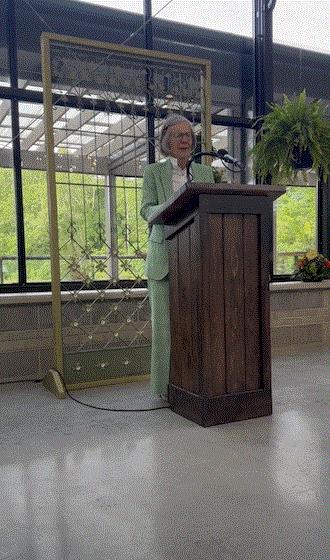
HERE IS A VIDEO brought to us by Seed Your Future that features Anna Ball, an early and enthusiastic supporter of the program, telling an audience about the time she spoke to an “Introduction to Horticulture for Non-Horticultural Majors” class at the University of Florida more than a decade ago. Afterwards, she was approached by some students who wanted to learn more … and many of them turned out to be engineering students who were fascinated by our industry, but had never heard of it! That experience planted the seed, so to speak, for Anna’s support of Seed Your Future.
Ball has supported Seed Your Future financially for 10 years and they encourage you to consider doing so, too. Specifically, you could join the “Seed Your Impact” campaign, which is running now through the end of the year. The initial goals is $20,000, which will help to:
- Engage 1,000-plus teachers with new science and horticulture lesson plans developed by the 2024 Seed to STEM cohort
- Publish 30 new lesson plans integrating horticulture with Math, English and Art
- Connect 4,000-plus students and 125-plus businesses during each Green Career Week, which occurs twice a year
- Increase website resource utilization by 20%, reaching more than 480,000 annual page views
So far, they’re at $4,085, so they’ve got work to do on this campaign. You can help out by going HERE to learn more and to donate.

USDA Deputy Secretary drops in at Dramm
I like it when one of our own small businesses (small only when compared to the big multinationals like Ford and Microsoft) gets a visit from a government policymaker. That’s what happened this week in Manitowoc, Wisconsin, when USDA Deputy Secretary Xochitl Torres Small paid a visit to Dramm Corp. to promote a grant that Dramm and others have received that supports fertilizer production in the U.S. instead of offshore—to help with food security, rising costs and the like.
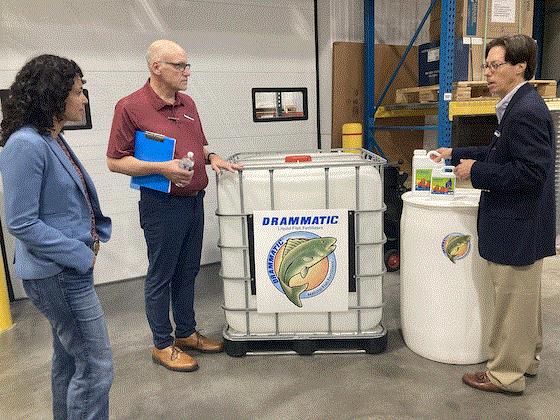
Deputy Secretary Xochitl Torres Small with Fertilizer Production and Compliance Manager Fritz Dramm (middle) and his cousin, President Hans Dramm.
Yes, Dramm makes fertilizer, in case you didn’t know. Dramm produces Drammatic Liquid Fish Fertilizers derived from fish offal collected from commercial and sport fishermen. This line of fertilizers is used in organic and conventional farming, as well as consumer gardening. The process keeps millions of pounds of fish waste out of our landfills and waterways. Dramm will use the $776,000 grant to increase production capacity at its fish processing plant in Algoma, Wisconsin, increase its customer base and install solar panels.
Back to the USDA grants: It’s called the Fertilizer Production Expansion Program (FPEP) and to date it's invested more than $368 million in 67 projects, creating new jobs and increasing domestic fertilizer production across the country. This go-round six more fertilizer producers, including Dramm, get a total of $120 million to expand and improve production.
“When we invest in domestic supply chains, we drive down input costs and increase options for farmers,” the Deputy Secretary said.
Meat producers are getting grant help, too, through the Local Meat Capacity Grant Program, which has awarded $20.2 million 26 projects to expand processing capacity within the meat and poultry industry.

Growing Lunar New Year potted mums
Dagnabbit. Seeing how this IS Week 44 and you need to direct-stick cuttings this week, it’s a bit too late for this year, but put it in the tickle file for next year: Lunar New Year potted mums.
Syngenta Flowers just sent out a nice cultural email on the crop, writing:
“Lunar New Year, also known as Spring Festival, is one of the most important and widely celebrated holidays in China and other Asian countries. This vibrant festival, marking the beginning of the Lunar New Year, is steeped in rich traditions and symbolism. Among the many customs associated with this auspicious occasion, the chrysanthemum, or ‘mum,’ holds a special place. These elegant flowers are not only prized for their beauty, but also carry deep cultural significance. Chrysanthemums symbolize longevity, good luck and resilience, making them a popular and meaningful decoration during this festive period. Yellow mums, in particular, are highly valued, as the color represents wealth, prosperity and power. These golden blooms are believed to attract good fortune and financial success, making them a favored choice for home decorations and gifts as a colorful reminder of the hopes for prosperity in the year ahead.”
The variety they suggest is called Golden Gate, a yellow decorative incurve with big, showy flowers, perfect for disbudding. Grow it in pots from 6 in. to 12 in.
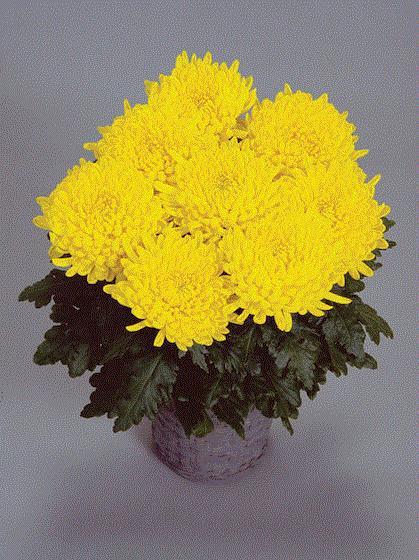
Here’s their suggested schedule:
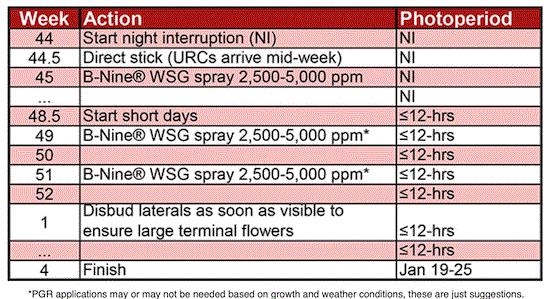
And a few tech tips:
- Use night interruption (NI) lighting to provide long days (short nights) by supplying 2-4 µmol.m-2.sec-1 from 10:00 p.m. to 2:00 a.m. each night. Confirm your NI is working as planned before URCs arrive.
- Lower the night temperature to 56 to 60F (13 to 15C) during the final three to four weeks of development to enhance flower color and strengthen stems.
-Reduce the fertilizer rate to target a substrate EC of 1.25 to 2.5 mS/cm (PourThru method) to improve post-harvest longevity.
-Plant odd numbers per pot, as even numbers are considered unlucky.

Put the Heimos Poinsettia Trial on your calendar now!
Just so you don’t forget and miss the biggest poinsettia trial in North America*, mark your calendar for Thursday, November 21. That’s when you’ll want to be in Millstadt, Illinois, just across the river from St. Louis, for the 17th Annual Millstadt Young Plants and N.G. Heimos Greenhouses Poinsettia Trial and Open House.
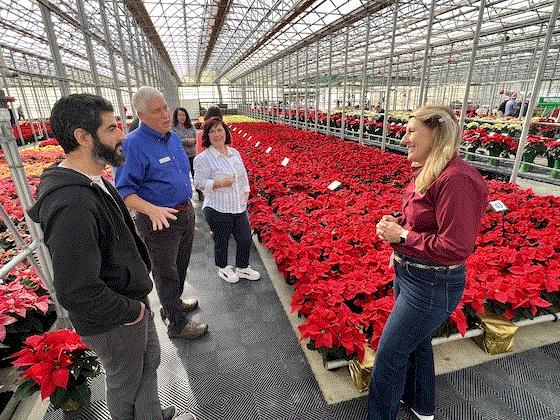
Amy (Heimos) Morris talks poinsettias with the Ball Publishing crew and Selecta One's Gary Vollmer at their 2023 trial. Selecta is one of seven breeders that will be represented again this year.
The open house will be showcasing a comparison trial of almost 200 poinsettia varieties from seven different breeders: Beekenkamp, Dümmen Orange, Express Seed Company, Lazzeri, Rinehart, Selecta One and Suntory. All plants will be finished naturally and short-day, so you can compare the difference. A light breakfast and lunch (always delicious) will be provided by the sponsors. You can even get a discount rate on your lodging at the Hampton Inn in Columbia, Illinois.
Interested? Need more info? Contact Susie Hines at shines@ngheimos.com or call her at (618) 476-3617.
*According to Amy Morris, they’ve got an acre of display space featuring 7,824 pots in 199 varieties. Another 597 pots are up on the tables in order by color, size and ready date. And they’ve got 4,082 pots in 118 varieties of top secret-off limits-stealth mode-Area 51 trials just for the breeders—that’s more than 17,000 pots grown solely for their poinsettia trials. Or as Amy succinctly puts it: “There are a lot of plants here!”

The 2025 trends according to LiveTrends
This next fine item is from Green Profit managing editor Jen Polanz from her recent visit to the Global Produce & Floral Show in Atlanta.
There’s no better indicator of what could be popular than visiting the LiveTrends booth at Global Produce & Floral Show in the fall. This company, led by founder/CEO Bisser Georgiev, has a team of creative young designers who have their finger on the pulse of what consumers are looking for (thanks in part to their own storefront in Winter Garden, Florida, where they can test products).
So what are they looking at for 2025?
The company has always been known for sleek, modern designs. But what was once cool in blacks, whites and grays are now warmer, more natural tones in brown, beige and terracotta, along with natural fibers and woven materials.
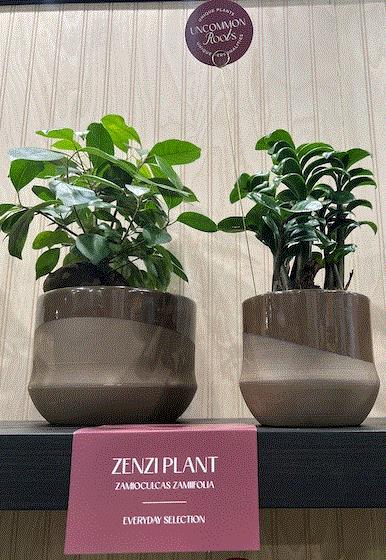
In an interesting blend of natural material and technology, they introduced a new line of LED-lit products called Illuminate, which feature a sophisticated wood base and glass globe with an LED light.
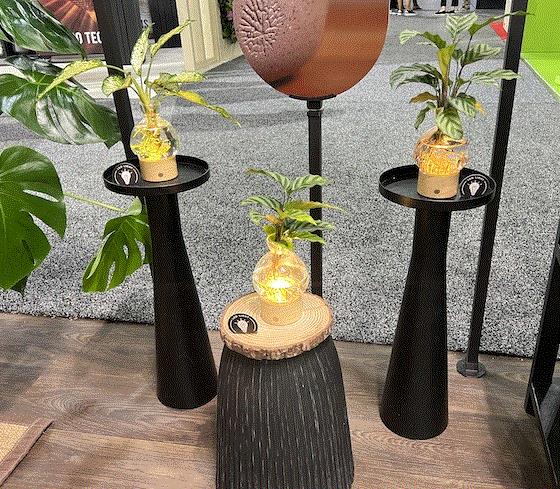
LiveTrends also combined its focus on sustainability with its offerings of self-watering pots by creating a new line made of recycled materials like straw scraps, wheat shells and coffee hulls, among other products.
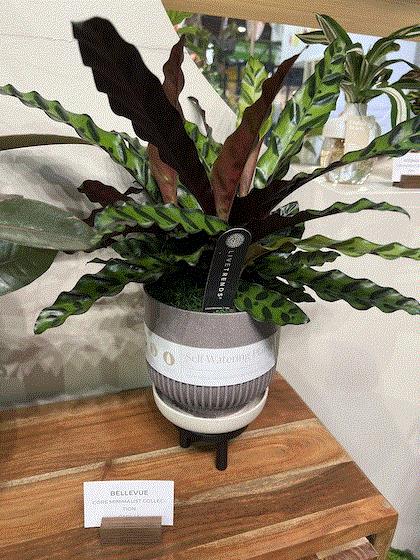

LiveTrends makes Golden 100
In more LiveTrends news, congrats to the company for once again being named to Orlando Business Journal’s Golden 100, recognizing Orlando’s 100 largest privately held businesses. This year, they reached #29 on the list (last year they were #31).
“We always strive to be the best, not biggest,”said the company on their LinkedIn page. “Still, we are honored to receive the #29 spot on Florida’s Top 100 Privately Held Companies. Thank you to our incredible retail partners and team members who got us here.”
Retail garden center Lucas Nursery and Butterfly Encounter also made the list (I couldn't access their ranking).
Did you see the Fall River Ridge Report?
I sent it out on Halloween. If you missed it while bobbing for apples or something, you can read the whole fascinating story HERE. But for a recap:
Decorating was down by three points from last year, to 66% of my River Ridge neighbors (236 homes out of 356 had some sort of fall/Halloween décor). That’s also three points below the 10-year average. But it’s only 10 houses, so nothing to get worked up about.
More importantly, flower use was UP fully 8 points over last year and 10 points above the 10-year average. Forty-two percent of the homes that decorated used mums, kale or some other fall flower in their displays. Last year it was just 34%. Nice!
How have fall plant sales been where you ply your trade? Strong? Flat? Down? Or have you been too focused on poinsettias to notice? Weigh in HERE.
Finally I …
Happy 50th anniversary to Ton Koers, growing advisor for Schoneveld Breeding … and that’s WORK anniversary! How in the world could Ton have worked for 50 years unless he started at 10 years old?
According to his LinkedIn profile, he started with Schoneveld in August 1974 and that's his ONLY place of work listed. Respect! I’ve been talking cyclamen with Ton for as long as Schoneveld has been displaying them at the California Trials or the big trade shows, and he’s the friendliest, most knowledgeable plantsman you could want to meet.
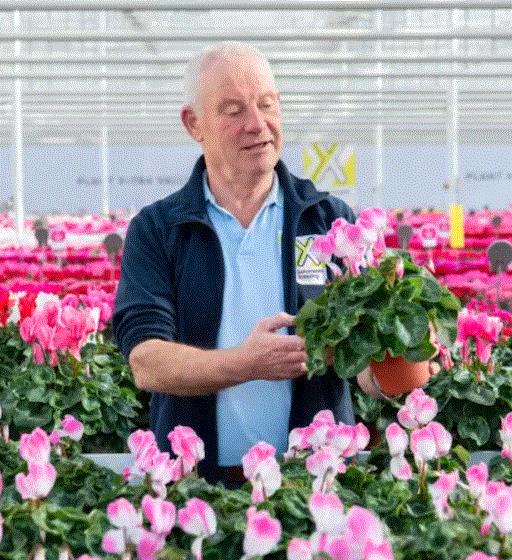
Here he is doing what he does best: Talking cyclamen, in this case Schoneveld’s Fusion F1.
Congrats, Ton! May you have 50 more!
Finally II …

How does Hortistician Dr. Marvin Miller decorate for fall? To spectacular effect, I must say. He sent me this photo, thinking I’d be missing fall in Orlando (I’m not; in fact, I hate that my pool has gotten a bit chilly).
But back to Marvin’s display ... an artful collection of kale, pumpkins, gourds and mums, some still-pretty spring annuals, and a corn stalk nestled in casual fashion into the natural landscape at the front of his townhouse. The mums and kale came from Galema's Greenhouse in West Lafayette, Indiana. Marvin used some straw bales to create the different heights in the display.
Wrote Marvin of his display when I asked him for more, “Fall is a glorious time and one that is sometimes overlooked by consumers, retailers and even growers. The range of colors and textures is wide. Pumpkins just don’t come in orange anymore, but white, peach, blue, yellow and tan are common colors as well. Add in a range of sizes and shapes and some gourds and you’re on your way to appreciating nature’s bounty. Mums certainly can run the gamut of colors, as well. Perhaps the greatest range of textures can be seen in the ornamental cabbages and kales. Put this altogether, possibly with some leftover annuals, and you can have a feast for the eyes!”
And you thought he only dealt in data ...


Feel free to email me at beytes@growertalks.com if you have ideas, comments or questions.
See you next time!

Chris Beytes
Editor-in-Chief
GrowerTalks and Green Profit
This e-mail received by 28,979 loyal readers!
Thanks to my loyal sponsors, who help me reach the 28,979 readers of Acres Online in more than 60 countries. Want to be one of them (a sponsor, that is)? Give Kim Brown a shout and she will tell you about our many advertising opportunities.